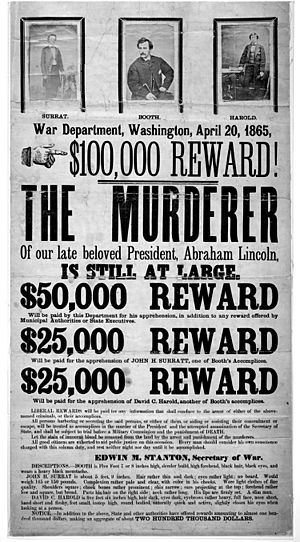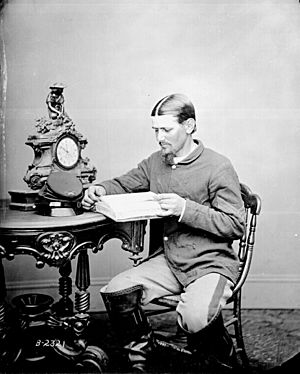Boston Corbett facts for kids
Quick facts for kids
Sergeant
Boston Corbett
|
|
|---|---|

Corbett c. 1864–1865
|
|
| Birth name | Thomas H. Corbett |
| Nickname(s) |
|
| Born | January 29, 1832 London, United Kingdom |
| Died | c. September 1, 1894 (aged 62) (presumed) Near Hinckley, Minnesota, U.S. |
| Allegiance | |
| Service/ |
|
| Years of service | 1861–1865 |
| Rank | Sergeant |
| Unit | 12th Regiment New York Militia 16th New York Cavalry Regiment |
| Battles/wars | American Civil War |
| Other work | Hatter |
| Signature | |
Thomas P. "Boston" Corbett (born in 1832) was a soldier in the Union Army. He is known for shooting and killing John Wilkes Booth, the person who assassinated President Abraham Lincoln. Corbett disappeared after 1888. It is thought he died in Minnesota around 1894, but this has never been fully proven.
Contents
Early Life of Boston Corbett
Corbett was born in London, England. His family moved to New York City in 1839. He learned the skill of making hats and worked as a hatter in Troy, New York. Some people believe that the chemicals used in hat making, like mercury, might have affected his mind later in life.
Corbett got married, but his wife passed away. After this sad event, he moved to Boston. He continued his work as a hatter there. He became a very religious Christian and changed his first name to Boston. He grew his hair very long, trying to be like Jesus.
Joining the Union Army
When the American Civil War began, Corbett joined the Union Army. He signed up three times to serve. He eventually became a Sergeant in the 16th New York Cavalry. On June 24, 1864, soldiers from the Confederate Army captured him. He was held in a prison camp called Andersonville prison.
Later, he was set free in a prisoner exchange. He then returned to his army unit. Corbett later spoke in court against the leader of the Andersonville prison, Captain Henry Wirz.
The Hunt for John Wilkes Booth
On April 24, 1865, Boston Corbett was part of a group of cavalry soldiers. Their mission was to find John Wilkes Booth. Booth had just assassinated President Abraham Lincoln and was still on the run. Two days later, on April 26, the soldiers found Booth and his helper, David Herold. They were hiding in a tobacco barn on a farm in Virginia.
The soldiers set the barn on fire to try and make them come out. Herold gave up, but Booth stayed inside. Corbett was standing near a large crack in the barn wall. He saw Booth moving around and shot him with his Colt revolver. This happened even though the Secretary of War wanted Booth to be captured alive. Booth was hit in the neck and died a few hours later.
Corbett was immediately arrested for not following orders. However, the charges were later dropped by the Secretary of War, Edwin M. Stanton. Stanton later said, "The rebel is dead. The patriot lives." Corbett received a share of the reward money, which was $1,653.84.
Corbett officially stated that he shot Booth because he thought Booth was going to use his weapons. Other witnesses did not agree with this. When asked later why he shot Booth, Corbett said that "Providence directed me." This meant he felt God guided him.
Life After the Army
After leaving the army, Corbett went back to making hats. He worked in Boston, and later in Connecticut and New Jersey.
As time went on, his behavior became more unusual. In 1875, he threatened some men with a pistol at a soldier's gathering. In 1878, he moved to Concordia, Kansas. There, he lived in a hole he dug in a hillside. In 1887, he got a job as an assistant doorkeeper for the Kansas government. He overheard people making fun of a prayer. He then pulled out a revolver. No one was hurt, but Corbett was arrested. He was declared mentally unwell and sent to the Topeka Asylum for the Insane.
On May 26, 1888, Corbett escaped from the asylum. He went to Neodesha, Kansas, and stayed briefly with a man he had met in the Andersonville prison. When he left, he said he was going to Mexico. It is possible that Corbett settled in the forests near Hinckley, Minnesota. He might have died in the Great Hinckley Fire, a large fire that happened there on September 1, 1894. There is no clear proof of his death. However, the name "Thomas Corbett" is on the list of people who died or went missing in that fire.
There is a monument for Boston Corbett on the side of the road near Concordia, Kansas.
See also
 In Spanish: Boston Corbett para niños
In Spanish: Boston Corbett para niños



